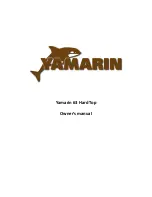
Fuel System
The 244CC is equipped with a single, 140 Gallon, pressurized fuel tank. The tank is of Polyethylene construction and is insulated with foam during
the construction of the boat. The tank is located under the center floor board of the boat. There is a sending unit installed in the tank. Inspection
ports in the deck and head compartment provide access to tank fittings.
There are two fuel pickups installed in the tank. If the boat is rigged for single engine, the port pickup will be plugged and only the starboard
pickup will be used. The pickups incorporate shut off valves than can be accessed through the in deck inspection plate under the leaning post.
There is an on deck fuel fill located on the port side of the boat, just forward of the console. Access to the fill is provided through an inspection
port. The tank vents through an EPA Carbon Canister, located in the anchor locker, which than vents overboard through a vent fitting on the
starboard side of the hull. Access to the vent is provided through an inspection port. It is recommended that these connections be inspected
annually.
The 244CC will come pre-rigged from the factory with Fuel Water Separator(s). The fuel water separators are installed in the bilge and accessed
through the bilge access hatch located in the aft cockpit. Fuel Water separators should be checked often to ensure the fuel is free of water. Fuel
should be disposed of in an approved waste collection device when servicing/replacing. The filter(s) must be filled with fuel after
servicing/replacing them in order to prime the engine.
A primer bulb for each engine is located adjacent to the Fuel Water Separator. It is used to prime the engine and system before starting the
engines. This should be done after service or after long periods of downtime for the boat.
All components of the 244CC Fuel System are approved for use with ethanol blended fuels up to 10%. E85 fuel should never be used. Key West
recommends using non ethanol fuels whenever possible to reduce the risk of moisture retention in the fuel system, especially in areas of high
heat/humidity.
When refueling the 244, whether on trailer or at a marina, the pressurized system will prevent overfilling. During fueling, check to ensure air is
escaping from the tank vent on the starboard side. Any blockage of the vent/vent line will prematurely trigger the shut off on the fuel nozzle and
will prevent you from filling the tank completely.
Due to the emission requirements of the EPA, certified fuel tanks and systems will not fill to the top of the tank. Instead, there will be a ullage in
the top 10% of the tank. The specified capacity of the tank (140 Gallons) accounts for this ullage, however it is important to note that fuel senders
do not account for this. Therefore, filling the tank to 140 Gallons will not indicate “Full” on the gauge. When using your boat, it is a good practice
to keep a log and a running count of how much fuel you’ve used. Do not rely on the fuel gauge exclusively as variations will occur.




































